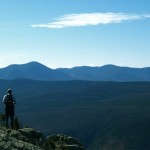When I’m walking up a mountain, my body and mind are disconnected. Body progresses automatically over the trail’s rocks and roots, while mind mulls over randomness: New ways to cook squash, plots to Kurt Vonnegut novels, gifts I need to buy, if I’ve seen more than one movie with Angelina Jolie (incredibly, only Girl Interrupted). But invariably, after trudging steeply uphill for three hours, or hauling myself up endless slabs of granite, or hopping fearfully on rocks through mud and water, all my mind is concerned with is two things: 1- These ruggedized sneakers just aren’t cutting it, I’m really going to buy hiking boots, and 2-Why am I doing this?
I reach the summit and take in the view. Being on top of a mountain is an undeniable thrill. Even if there’s 0 visibility or an obscured view, the air’s scant-oxygen freshness is intoxicating. And as my body recovers and my mind forgets all about its recent agony, it thinks again: Why am I doing this? Why is hiking pleasurable? Why is this view magnificent?
Venturing into nature for no particular reason wouldn’t seem a logical compulsion for any human. Perhaps it’s an evolutionary relic from our hunter-gatherer days, when meandering through the woods would be a good urge. Or it’s more molecular; we are simply hard-wired to roam.
Or hikers are simply conquering modern-day malaise by seeking mini-adventures. Many hikers, myself included, have a “peak-bagging” mentality. I’m slowly ticking off summits from the Four-Thousand-Footers in the White Mountains I’ve done 5 out of 48. I toy with the idea of making a concerted effort to join the 4000 Footer Club and do all 48. It’s a distinction with well-deserved bragging rights.
43 to go. At this rate, I’ll be tramping up mountains when I’m 60, my mind wondering, why am I still doing this?
Actually, putting another feather in my 4000 Footer cap was probably the least interesting thing I did on my vacation, but it’s certainly the most photographed.


